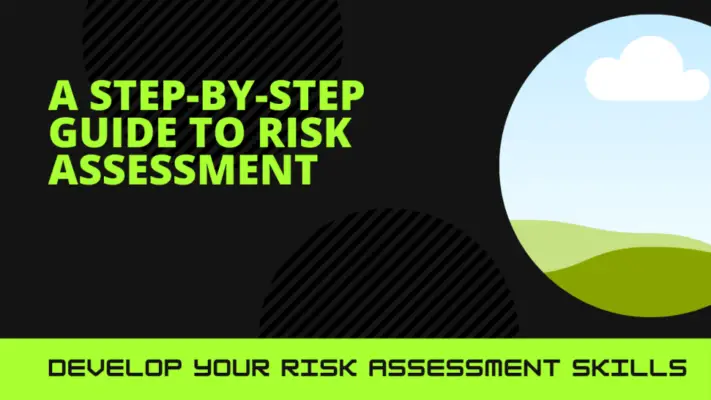Risk assessment, a systematic approach to identifying potential hazards and evaluating the potential impact of these hazards, plays a pivotal role in any decision-making process.
Different types of risk assessments provide varied insights into potential risks, each with its unique approach and focus. These assessments include:
- Quantitative Risk Assessments utilize numerical values for both probability and impact of risk.
- Qualitative Risk Assessments, which use descriptive methods to identify risks.
- Semi-Quantitative Risk Assessments blend elements of both previous types.
- Asset-Based Risk Assessments focus on specific assets within an organization.
- Vulnerability Risk Assessment, assessing susceptibility to hazards.
- Threat-Based Risk Assessments, evaluating potential dangers.
This article delves into these types, providing an in-depth understanding of their applications and significance, thereby facilitating a more comprehensive grasp of risk assessment methodologies.

What Types of Risk Assessments Are There?
Several types of risk assessments exist, including but not limited to health and safety, environmental, project, financial, and business risk assessments, each specifically designed to identify potential hazards and evaluate the likelihood of their occurrence within their respective domains.
Qualitative risk assessments, for instance, focus on identifying potential risks and their subjective impact, while quantitative risk assessments involve numerical measurements of risk level and potential impact.
Regardless of the type of risk assessment, the risk assessment process is a systematic procedure to understand, evaluate, and address these risks.
On the other hand, site-specific risk assessments are tailored to the unique characteristics of a given location or situation, further exemplifying the diverse range of methodologies employed in risk assessment processes.
When conducting site-specific risk assessments, it is important to consider risk communication, items, cost-benefit analysis, and modeling techniques.
Decision makers should also consider the frequency of occurrence and implement quality control measures to ensure corrective actions are taken as necessary. It is essential to follow internal policies and maintain open channels of communication, including regular intervals, for a complete assessment.
Senior management should oversee the risk analysis framework, with a designated risk assessment project manager and a Risk Analysis Working Group.
Risk analysis teams, risk communication teams, and risk reduction measures should also be established, with a dedicated Risk Analysis Coordinator and risk communicators.
Prioritizing risks, understanding their nature, communicating them effectively, and managing them appropriately are crucial tasks for any organization. Some key components of this process include risk ranking, risk characterization, risk communications, candidate risk assessments, risk assessment questions, and risk assessment team members.
You may consider joining a Risk Assessment Consortium or forming a Risk Communications Team to enhance these efforts. To reduce risks, you can analyze risk reduction and design strategies accordingly.
Risk analysis typically involves identifying non-financial risks and evaluating the responsibilities of risk managers, the participation of risk analysis participants, and the leadership of the risk assessment team.
When dealing with risks, it’s important to have a systematic and comprehensive approach covering different risk management aspects. For instance, you may need to rank risks according to their likelihood and impact, characterize risks based on their sources and consequences, and communicate risks to relevant stakeholders.
You may also need to assess the qualifications of potential risks and ask specific risk assessment questions to gather relevant information. To broaden your perspective and share best practices, you could join a Risk Assessment Consortium or collaborate with other organizations.
To mitigate risks, you might analyze the nature of risk reduction and design appropriate solutions. Risk analysis can involve non-financial risks, such as reputational, legal, or environmental risks, and requires the involvement of various roles, such as risk managers, risk analysis participants, and risk assessment team leaders.
The first step is to assess the risks, followed by making decisions regarding risk management. A designated leader and team should handle risk management using a matrix approach.
The risks involved in introducing new factors should be evaluated, and various types of risk analysis can be utilized. It’s crucial to communicate broader risk messages effectively.
Some important topics to consider include the identification of critical risks, the characterization of hazards, the potential regulatory impact, and any adverse effects that may occur. It’s also important to think about the potential for adverse health effects and any domino effects that may follow.
Planning and performance steps should be taken with adequate and sufficient resources, and product quality should be a priority when considering drug products. Additionally, a series of values should be considered when making policy decisions.
Quantitative Risk Assessments
Delving into Quantitative Risk Assessments, a data-driven approach utilizes numerical values and probabilities to determine potential losses. This type of assessment uses statistical methods to quantify risk factors, thereby providing a numeric estimate of the potential impact and likelihood of occurrence of a risk event.
A key component of the risk management process, quantitative risk assessments offer a rigorous and objective analysis that helps decision-making.
The risk assessment model used in this approach is typically based on algorithms or formulas that incorporate the various risk factors. These models can range from simple calculations to complex simulations.
The aim is to translate the uncertainties and variabilities associated with risks into comprehensible and actionable numerical values.
Qualitative Risk Assessments
Shifting the focus to Qualitative Risk Assessments, a different approach is explored that hinges on the subjective analysis of potential threats and their impacts.
This method, known as qualitative risk analysis, incorporates hazard identification as a fundamental step. It seeks to identify potential threats, evaluate risk levels, and propose appropriate control measures.
Three crucial steps in conducting qualitative risk assessments are:
- Risk Identification: This involves recognizing potential hazards and vulnerabilities that could present risks.
- Risk Rating: The identified risks are prioritized based on their potential impact and likelihood.
- Control Measures: After the level of risk is determined, suitable response strategies are formulated to manage or mitigate the risk.
Qualitative risk assessments provide valuable insights into the potential threats associated with an activity or process.
Semi-Quantitative Risk Assessments
Transitioning to Semi-Quantitative Risk Assessments, a hybrid approach balances the subjectivity of qualitative analysis with the objectivity of quantitative measurements.
This type of assessment introduces numeric values into the risk matrix, thus providing a more standardized and precise evaluation.
The semi-quantitative risk assessments hinge upon two fundamental factors: the probability of occurrence and the degree of risk.
These assessments assign numerical ratings to the identified risks, generating a risk score.
This score aids in prioritizing the risks based on their potential impact.
The semi-quantitative risk analysis, therefore, offers a more nuanced understanding of risk scenarios, bolstering decision-making processes.
It bridges the gap between qualitative and quantitative assessments, leveraging the strengths of both types of assessments.
Asset – Based Risk Assessments
Venturing into the domain of Asset-Based Risk Assessments, it is pertinent to note the emphasis on identifying, analyzing, and addressing vulnerabilities associated with an organization’s tangible and intangible assets.
This form of risk assessment is primarily concerned with the potential hazards that could compromise the value or function of these assets.
- An ‘asset-based assessment’ involves a comprehensive evaluation of the risk posture towards each asset, including physical and intellectual properties.
- The ‘risk assessment team’ systematically identifies and catalogues all assets.
- The team then identifies ‘potential hazards’ that could pose operational risks to the assets.
- The ‘risk assessment form’ captures the potential financial impact of these risks.
- Lastly, measures are implemented to mitigate these risks, enhancing the organization’s overall risk posture.
Vulnerability Risk Assessment
This is another crucial type of risk assessment that identifies potential weaknesses which may be exploited, leading to significant damage or loss. This method uses qualitative and quantitative assessments to determine the severity and likelihood of risks.
| Qualitative Assessments | Quantitative Assessments | |
|---|---|---|
| Definition | Subjective risk evaluations | Objective numerical data |
| Application | Common hazards identification | Risk assessment matrices |
| Considerations | Generic risk assessment | Dynamic risk assessment |
Vulnerability Risk Assessment considers environmental factors that could potentially be common hazards. These assessments are dynamic, meaning they change as the environment or situation changes.
This approach provides a more comprehensive, detailed, and scholarly understanding of risks, thus facilitating more informed decision-making.

Threat- Based Risk Assessments
Threat-Based Risk Assessment is a strategic approach focusing on identifying potential threats and their corresponding impact on an organization’s operations. This type of assessment is a fundamental risk assessment tool that provides insightful data regarding an organization’s risk exposures and helps formulate a management action plan.
Threat-Based Risk Assessments typically involve three key steps:
- Identification of Threats: This involves a comprehensive study of the threat landscape to identify potential future events that can negatively impact the organization.
- Assessment of Risk: The identified threats are evaluated using various assessment techniques to determine their potential impact.
- Development of Action plan: Based on the assessment, a management action plan is devised to mitigate the risks.
Therefore, Threat-Based Risk Assessments serve as a proactive strategy for organizations to manage their risk assessments effectively.
Frequently Asked Questions
What are the costs involved in performing a risk assessment?
The costs involved in performing a risk assessment encompass expenses for professional services, staff time, tools or software, and, potentially, additional resources for risk mitigation strategies following the assessment’s results.
Who are the professionals qualified to perform different types of risk assessments?
Qualified professionals for various risk assessments include risk analysts, environmental scientists, financial auditors, health and safety inspectors, IT security analysts, and cybersecurity consultants, each with specialized training in their respective fields.
How often should a risk assessment be conducted in a business organization?
Risk assessment frequency in a business organization is subject to various factors. However, it is often recommended that these assessments be conducted at least annually or when significant operational changes occur within the organization.
What are the legal implications of not conducting a risk assessment?
Failure to conduct a risk assessment may lead to legal consequences such as non-compliance penalties or litigation. Liability issues may arise, potentially resulting in substantial financial loss and damage to organizational reputation.
How do risk assessments interact with insurance policies?
Risk assessments play a pivotal role in insurance policies. They determine the degree of risk associated with insuring an entity, thus influencing policy premiums, coverage limits, and underwriting decisions. Their importance is undeniable in the insurance sector.

Conclusion
To effectively identify, categorize, and minimize risks, it is imperative to conduct various types of risk assessments. These assessments include quantitative, qualitative, semi-quantitative, asset-based, vulnerability, and threat-based assessments.
These methodologies, each with its unique approach and focus, provide comprehensive insights into potential hazards and their impacts.
Thus, adopting these risk assessment types is crucial for strategic decision-making, risk management, and ensuring organizational resilience against potential threats or vulnerabilities.

Chris Ekai is a Risk Management expert with over 10 years of experience in the field. He has a Master’s(MSc) degree in Risk Management from University of Portsmouth and is a CPA and Finance professional. He currently works as a Content Manager at Risk Publishing, writing about Enterprise Risk Management, Business Continuity Management and Project Management.


